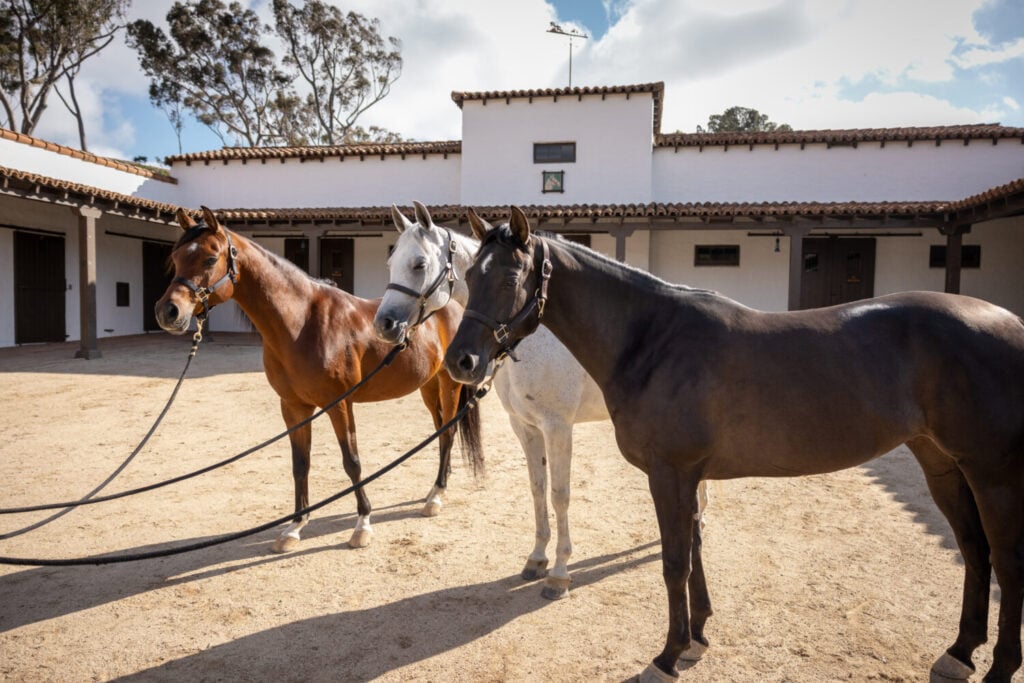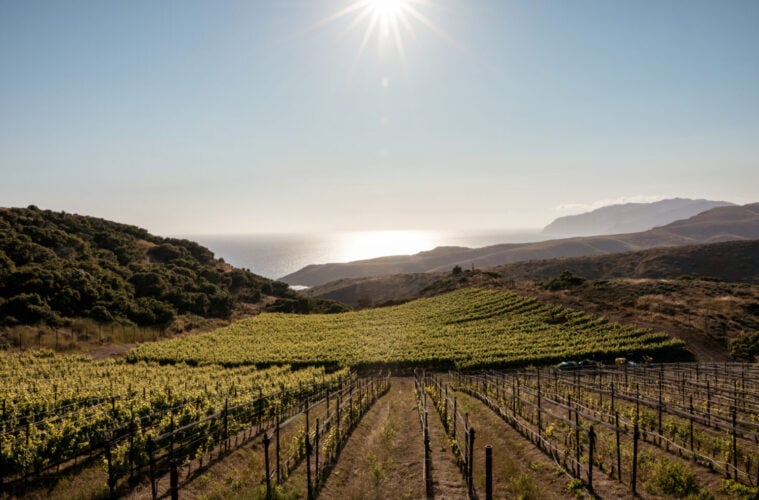When Alison Wrigley Rusack was just 6 months old, her parents, Alison Hunter Wrigley and William Wrigley, already had her on a horse on their ranch in Catalina Island. That legacy, with many others of the famous chewing gum family, was handed down to the fifth generation, when Alison found herself on the back of an Arabian horse with one hand holding the reins and the other taking turns with the bottle-feeding of sons Austin, Hunter and Parker.
Beginning this month, the Catalina Island Company offers tours of the hidden family horse ranch, known as El Rancho Escondido, built in 1930 by Alison’s grandparents. The journey starts in the City of Avalon into rugged terrain by way of Stagecoach Road on a fully restored 1950s Flxible Bus used for tours past on the island, and meanders through buffalo herds and other notable eco sights with detailed tour guide tales.

El Rancho Escondido (Michele Stueven)
Located 14 winding miles into the island’s interior just past the Airport in the Sky and three miles from Catalina’s westside, the ranch is also used to sustainably grow Chardonnay and Pinot Noir grapes for Rusack Vineyards in Santa Ynez, from which the family sources their award-winning wines. Alison and her husband of 40 years, Geoff Rusack, also showcase a Zinfandel variety that comes from a handful of resilient vines thriving on Catalina’s sibling island, Santa Cruz. The vines on Catalina were first planted in 2007 and harvested in 2009, and the fruit is flown to Santa Ynez for processing under winemaker Steve Gerbac’s watchful eye and distinguished palate.
The quail like the grapes, the native Catalina foxes like the grapes and the wasps like the grapes. To maintain the high quality of the fruit, the grapes are picked at night so they can arrive at the winery as early and as cool as possible. Austin is the brand manager at Rusack Vineyards.

The Bishop’s Chapel (Michele Stueven)
The 16-stall horseshoe-shaped stables and courtyard of the original structure have been restored to their 1930 splendor, still maintaining the bricks and roof tiles made from Catalina’s famous clay, whose tiles dot structures throughout the city of Avalon. A large trophy room and museum have been added, touting the family’s extensive equestrian history and accomplishments. Live horse demonstrations are part of the tour underneath towering Eucalyptus trees.
In 2021, the Bishop’s Chapel was dedicated on the property’s hilltop as an homage to Geoff’s father, Robert Claflin Rusack, the fourth episcopal bishop of the Diocese of Los Angeles in 1960 at St. Paul’s Cathedral in downtown Los Angeles. The church was built in 1923, on Figueroa Street north of Wilshire Boulevard, and demolished in 1980 after earthquake damage. Tour guides detail the history of JORY’s Bell, the Baptismal Font and the original stained-glass windows featured in the small, serene chapel.
“It was my husband’s dream as a memorial to his parents to build a chapel here,” Alison tells L.A. Weekly during a recent wine-tasting in the chapel’s vestibule overlooking Shark Harbor and the remote Little Harbor campground. “We were inspired by the chapel on Santa Cruz island. We often to go over there for a service in the middle of nowhere. Joe Walsh of the Eagles fought hard to keep it there and is the chairman of the board of the Santa Cruz Island Foundation. He still does the music. I remember the first time, sitting in that chapel in the middle of the Channel Islands, and Joe Walsh was doing the music. A Catholic cardinal performed the service. It truly was spiritual.”

Alison Wrigley Rusack (Michele Stueven)
Also new to Catalina is the Flx Biergarten, the island’s first and only biergarten located in Avalon, run by son Hunter. Flx takes its name from the historic ’50s Flxible buses that carried tourists on the streets of Avalon and along the island’s interior. The open-air atmosphere across from the pier is decorated with string lights, restored tour buses and cozy fire pits around the centralized beer pong table. Hunter, like Austin, has been a constant in the Catalina legacy, including hands-on time spent working on the island’s dramatic zip line.
In 1975 William’s parents Philip Knight Wrigley, his wife Helen, and Philip’s sister, Dorothy Wrigley Offield, deeded 42,000 acres of Catalina Island to the Catalina Island Conservancy, a non-profit organization they had established three years earlier in 1972. About 20% of the island currently belongs to the Catalina Island Company, owned by Wrigley descendants, which provides a variety of tours, accommodation packages and excursions.
“It’s been a part of my life since day one,” says Alison, who still rides. “My great-grandfather, grandfather and father raised me to care about our legacy. It’s in my blood. It didn’t take much convincing living in Chicago in an apartment in the city to come out here. We’d go up to a house on the lake on the weekends, but coming here — especially for someone who loved horses like I did — was an amazing experience. I fell in love with it and brought my kids to the island when they were little. Everything here has a story and a reason behind it. Catalina is a treasure that we want to protect and preserve and have taught the future generations to do the same.”

The trophy room (Michele Stueven)

Hunter Rusack at Flx Biergarten (Michele Stueven)

Austin Rusack (Michele Stueven)

El Rancho Escondido (Courtesy Catalina Island Co.)
Advertising disclosure: We may receive compensation for some of the links in our stories. Thank you for supporting LA Weekly and our advertisers.

